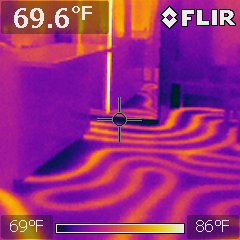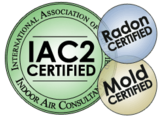
Thermal imaging or infrared, is one of the specialty tools used during a HomeTech inspection. This unique tool has many applications during a home inspection and is included in the inspection price. HomeTech uses this tool on an as needed basis to help in the overall inspection process. This is not a tool that will give all the answers or discover all unforeseen issues. It is however helpful in generating a more accurate overall impression of the home. In a typical inspection we will run a scan of the interior of the home and certain systems in an attempt to identify any potential issues. NOTE: we do not provide energy evaluation or a full thermal imaging report as part of the typical Home Inspection or Mold Inspection. If you would like a thermal imaging infrared inspection for specific reasons other than a home inspection or mold inspection, please call us to discuss options.
How does thermal imaging work and why is it an important part of a home inspection? Read on to learn more!
Please NOTE: the following article was written by an outside party and may not reflect how thermal imaging is used and represented in a typical Hometech Inspection, please call us with any questions regarding Thermal imaging used in an inspection. We do not include thermal reports along with a general home inspection reports or mold reports, we DO always use this tool as needed during the inspection process and may include images in the report only if warranted.
Thermal Imaging Reports (article courtesy of NACHI)
by Nick Gromicko and Kate Tarasenko
Infrared (thermal imaging) is an advanced, non-invasive technology that allows the inspector to show homeowners things about their homes that can’t be revealed using conventional inspection methods. For something as specialized as a thermal imaging inspection, it’s critical to understand some details on how this works.
Here are some important things to remember:
- There are limitations of thermal imaging, including the fact that, as with any type of inspection, it can’t predict future conditions. However, a roof that is experiencing moisture intrusion which has been detected through thermal imaging will very likely lead to serious structural issues, if left unaddressed.
- What can an Infrared camera detect?
In terms of energy loss, an IR camera can detect:
- heat loss and air infiltration in walls, ceilings, floors, windows and
doors;
- damaged and/or malfunctioning radiant heating systems;
- air-conditioner compressor leaks;
- under-fastening and/or missing framing members, and other structural defects that can lead to energy loss; and
- broken seals in double-paned windows.
In terms of detecting moisture intrusion, an IR camera can locate:
- plumbing leaks;
- hidden roof leaks before they cause serious damage;
- missing, damaged and/or wet insulation; and
- water and moisture intrusion around penetrations and at the foundation and building envelope that could lead to structural damage and mold.
IR cameras are equally effective at locating hot spots in the home, including:
- circuit breakers in need of immediate replacement;
- overloaded and undersized circuits;
- overheated electrical equipment and components; and
- electrical faults before they cause a fire.
Additionally, based on the color gradients that thermal images provide, a HomeTech inspector can locate:
- possible pest infestation, as revealed by energy loss through shelter tubes left by boring wood-destroying insects;
- the presence of intruders, such as rats, mice and other larger pests hiding within the structure and detected because of their heat signature that the IR camera captures; and
- dangerous flue leaks, which can lead to carbon monoxide poisoning of the home’s residents.
Infrared Images



